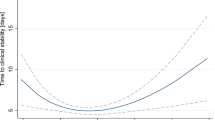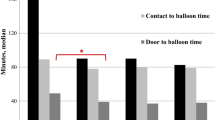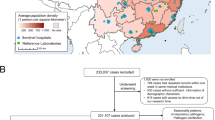Abstract
Objective:
Recent evidence suggests that obesity increases the risk of severe outcomes following respiratory infection. It is less clear whether obesity is associated with the risk of being infected with influenza or other respiratory pathogens. Therefore, we examined the association between obesity and outpatient visits for acute respiratory infections (ARIs).
Design:
We conducted a retrospective cohort study for a period of over 13 years on 104 665 individuals in Ontario, Canada who responded to population health surveys and agreed to linkage with health administrative data. Individuals aged 18–64 years who responded to a survey within 5 years prior to the start of an influenza season were included. Poisson regression, with adjustment for relevant confounders, was used to measure the association between self-reported body mass index (BMI) and outpatient visits for ARI. We conducted numerous sensitivity analyses to assess the robustness of our findings.
Results:
We observed higher rates of outpatient visits for ARI during influenza season periods compared with normal weight individuals for those who were overweight (BMI 25–29.9; rate ratio (RR) 1.10; 95% confidence interval (95% CI) 1.07–1.13), obese class I (BMI 30–34.9; RR 1.17; 95% CI 1.13–1.22) and obese class II or III (BMI ⩾35; RR 1.19; 95% CI 1.12–1.25). Associations of a similar magnitude were observed during non-influenza season periods. Obesity was a greater risk factor for ARIs managed in emergency departments than physician offices.
Conclusions:
Obese individuals are at an increased risk of outpatient visits for ARI during both influenza and non-influenza season periods, suggesting that the effect of obesity on the risk of respiratory infections is not limited to influenza. Interventions designed to reduce the prevalence of obesity may have the added benefit reducing the population burden of respiratory infections.
This is a preview of subscription content, access via your institution
Access options
Subscribe to this journal
Receive 12 print issues and online access
$259.00 per year
only $21.58 per issue
Buy this article
- Purchase on Springer Link
- Instant access to full article PDF
Prices may be subject to local taxes which are calculated during checkout
Similar content being viewed by others
References
World Health Organization. Obesity and overweight http://www.who.int/mediacentre/factsheets/fs311/en/index.html. 2012. 8-15-2012.
Tjepkema M . Adult obesity. Health Rep 2006; 17: 9–25.
Katzmarzyk PT, Mason C . Prevalence of class I, II and III obesity in Canada. CMAJ 2006; 174: 156–157.
Guh DP, Zhang W, Bansback N, Amarsi Z, Birmingham CL, Anis AH . The incidence of co-morbidities related to obesity and overweight: a systematic review and meta-analysis. BMC Public Health 2009; 9: 88.
Pi-Sunyer X . The medical risks of obesity. Postgrad Med 2009; 121: 21–33.
Poulain M, Doucet M, Major GC, Drapeau V, Series F, Boulet LP et al. The effect of obesity on chronic respiratory diseases: pathophysiology and therapeutic strategies. CMAJ 2006; 174: 1293–1299.
Karlsson EA, Beck MA . The burden of obesity on infectious disease. Exp Biol Med (Maywood ) 2010; 2352: 1412–1424.
Gardner EM, Beli E, Clinthorne JF, Duriancik DM . Energy intake and response to infection with influenza. Annu Rev Nutr 2011; 31: 353–367.
Huttunen R, Syrjanen J . Obesity and the risk and outcome of infection. Int J Obes 2012; 37: 333–340.
Sheridan PA, Paich HA, Handy J, Karlsson EA, Hudgens MG, Sammon AB et al. Obesity is associated with impaired immune response to influenza vaccination in humans. Int J Obes 2012; 36: 1072–1077.
Center for Disease Control. Intensive-care patients with severe novel influenza A (H1N1) virus infection—Michigan, June 2009. Morb Mortal Wkly Rep 2009; 58: 749–752.
Louie JK, Acosta M, Winter K, Jean C, Gavali S, Schechter R et al. Factors associated with death or hospitalization due to pandemic 2009 influenza A(H1N1) infection in California. JAMA 2009; 302: 1896–1902.
Louie JK, Acosta M, Samuel MC, Schechter R, Vugia DJ, Harriman K et al. A novel risk factor for a novel virus: obesity and 2009 pandemic influenza A (H1N1). Clin Infect Dis 2011; 52: 301–312.
Jain S, Kamimoto L, Bramley AM, Schmitz AM, Benoit SR, Louie J et al. Hospitalized patients with 2009 H1N1 influenza in the United States, April-June 2009. N Engl J Med 2009; 361: 1935–1944.
Morgan OW, Bramley A, Fowlkes A, Freedman DS, Taylor TH, Gargiullo P et al. Morbid obesity as a risk factor for hospitalization and death due to 2009 pandemic influenza A(H1N1) disease. PLoS ONE 2010; 5: e9694.
Yu H, Feng Z, Uyeki TM, Liao Q, Zhou L, Feng L et al. Risk factors for severe illness with 2009 pandemic influenza A (H1N1) virus infection in China. Clin Infect Dis 2011; 52: 457–465.
Dominguez-Cherit G, Lapinsky SE, Macias AE, Pinto R, Espinosa-Perez L, de la TA et al. Critically Ill patients with 2009 influenza A(H1N1) in Mexico. JAMA 2009; 302: 1880–1887.
Van K, Vandemaele KA, Shinde V, Jaramillo-Gutierrez G, Koukounari A, Donnelly CA et al. Risk factors for severe outcomes following 2009 influenza A (H1N1) infection: a global pooled analysis. PLoS Med 2011; 8: e1001053.
Diaz E, Rodriguez A, Martin-Loeches I, Lorente L, del Mar MM, Pozo JC et al. Impact of obesity in patients infected with 2009 influenza A(H1N1). Chest 2011; 139: 382–386.
Kwong JC, Campitelli MA, Rosella LC . Obesity and respiratory hospitalizations during influenza seasons in Ontario, Canada: a cohort study. Clin Infect Dis 2011; 53: 413–421.
Falagas ME, Athanasoulia AP, Peppas G, Karageorgopoulos DE . Effect of body mass index on the outcome of infections: a systematic review. Obes Rev 2009; 10: 280–289.
Tambay JL, Catlin G . Sample design of the national population health survey. Health Rep 1995; 7: 29–42.
Beland Y . Canadian community health survey—methodological overview. Health Rep 2002; 13: 9–14.
Thomas S, Wannell B . Combining cycles of the Canadian Community Health Survey. Health Rep 2009; 20: 53–58.
Health Canada. Canadian Guidelines for Body Weight Classificiation in Adults, 2003. Health Canada: Ottawa, Ontario, Canada, 2012.
Nawaz H, Chan W, Abdulrahman M, Larson D, Katz DL . Self-reported weight and height: implications for obesity research. Am J Prev Med 2001; 20: 294–298.
Shields M, Gorber SC, Tremblay MS . Estimates of obesity based on self-report versus direct measures. Health Rep 2008; 19: 61–76.
Gorber SC, Tremblay M, Moher D, Gorber B . A comparison of direct vs self-report measures for assessing height, weight and body mass index: a systematic review. Obes Rev 2007; 8: 307–326.
Shields M, Gorber SC, Janssen I, Tremblay MS . Bias in self-reported estimates of obesity in Canadian health surveys: an update on correction equations for adults. Health Rep 2011; 22: 35–45.
Chan B . Supply of physicians' services in Ontario. Institute for Clinical Evaluative Sciences: Toronto, Ontario, Canada, 1999.
Cadieux G, Tamblyn R . Accuracy of physician billing claims for identifying acute respiratory infections in primary care. Health Serv Res 2008; 43: 2223–2238.
Iron K, Zagorski BM, Sykora K, Manuel DG . Living and dying in Ontario: an opportunity for improved health information. ICES Investigative Report. Institute for Clinical Evaluative Sciences: Toronto, Ontario, Canada, 2008.
Wilkins R Automated Geographic Coding Based on the Statistics Canada Postal Code Conversion Files, Including Postal Codes to December 2003. Health Analysis and Measurement Group, Statistics Canada: Ottawa, Ontario, Canada, 2004.
Wong K, Campitelli MA, Stukel TA, Kwong JC . Estimating influenza vaccine effectiveness in community-dwelling elderly patients using the instrumental variable analysis method. Arch Intern Med 2012; 172: 484–491.
Naylor CD, Slaughter P . Cardiovascular health and services in Ontario: an ICES atlas. Institute for Clinical Evaluative Sciences: Toronto, Ontario, Canada, 1999.
Starfield B, Weiner J, Mumford L, Steinwachs D . Ambulatory care groups: a categorization of diagnoses for research and management. Health Serv Res 1991; 26: 53–74.
Baik I, Curhan GC, Rimm EB, Bendich A, Willett WC, Fawzi WW . A prospective study of age and lifestyle factors in relation to community-acquired pneumonia in US men and women. Arch Intern Med 2000; 160: 3082–3088.
Schnoor M, Klante T, Beckmann M, Robra BP, Welte T, Raspe H et al. Risk factors for community-acquired pneumonia in German adults: the impact of children in the household. Epidemiol Infect 2007; 135: 1389–1397.
Almirall J, Bolibar I, Serra-Prat M, Roig J, Hospital I, Carandell E et al. New evidence of risk factors for community-acquired pneumonia: a population-based study. Eur Respir J 2008; 31: 1274–1284.
Coleman LA, Waring SC, Irving SA, Vandermause M, Shay DK, Belongia EA . Evaluation of obesity as an independent risk factor for medically laboratory-confirmed influenza. Influenza Other Respi Viruses 2012; 7: 160–167.
Marsden-Haug N, Foster VB, Gould PL, Elbert E, Wang H, Pavlin JA . Code-based syndromic surveillance for influenzalike illness by International Classification of Diseases, Ninth Revision. Emerg Infect Dis 2007; 13: 207–216.
Acknowledgements
We would like to thank the sentinel laboratories participating in the Respiratory Virus Detection Surveillance System and the FluWatch team at the Public Health Agency of Canada for providing the viral surveillance data used in this study who received no financial compensation for their contributions. This study was supported by an operating grant from the Canadian Institutes of Health Research (XIN 82408). JCK was supported by a Clinician Scientist Award from the Department of Family and Community Medicine, University of Toronto. JCK and MAC received salary support from the Institute for Clinical Evaluative Sciences (ICES). This study was supported by the ICES, which is funded by an annual grant from the Ontario Ministry of Health and Long-Term Care (MOHLTC). The study sponsors did not participate in the design and conduct of the study, collection, management, analysis and interpretation of the data; preparation, review or approval of the manuscript; or the decision to submit the manuscript for publication.
Disclaimer:
The opinions, results and conclusions reported in this paper are those of the authors and are independent from the funding sources. No endorsement by ICES or the Ontario MOHLTC is intended or should be inferred.
Author contributions
Dr Kwong and Mr Campitelli had full access to all the data in the study, and take responsibility for the integrity of the data and the accuracy of the data analysis. Study concept and design: Campitelli, Rosella and Kwong. Analysis and interpretation of the data: Campitelli, Rosella and Kwong. Drafting of the manuscript: Campitelli and Kwong. Critical revision of the manuscript for important intellectual content: Campitelli, Rosella and Kwong. Statistical analysis: Campitelli and Rosella. Administrative, technical or material support: Campitelli. Funding and supervision for this study: Kwong.
Author information
Authors and Affiliations
Corresponding author
Ethics declarations
Competing interests
The authors declare no conflict of interest.
Rights and permissions
About this article
Cite this article
Campitelli, M., Rosella, L. & Kwong, J. The association between obesity and outpatient visits for acute respiratory infections in Ontario, Canada. Int J Obes 38, 113–119 (2014). https://doi.org/10.1038/ijo.2013.57
Received:
Revised:
Accepted:
Published:
Issue Date:
DOI: https://doi.org/10.1038/ijo.2013.57
Keywords
This article is cited by
-
Obesity and infectious diseases: pathophysiology and epidemiology of a double pandemic condition
International Journal of Obesity (2022)
-
Body mass index and infectious disease mortality in midlife in a cohort of 2.3 million adolescents
International Journal of Obesity (2018)
-
Is weight associated with severity of acute respiratory illness?
International Journal of Obesity (2018)
-
Association between body mass index and laboratory-confirmed influenza in middle aged and older adults: a prospective cohort study
International Journal of Obesity (2018)



